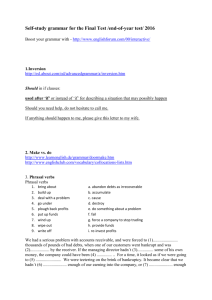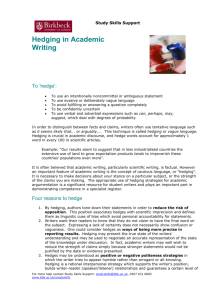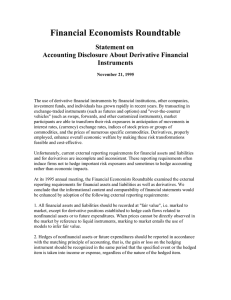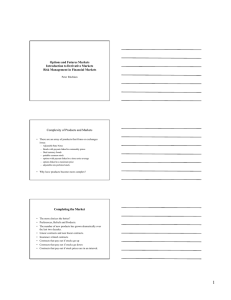AcSB Implementation Guide Hedging Relationships Typescript
advertisement
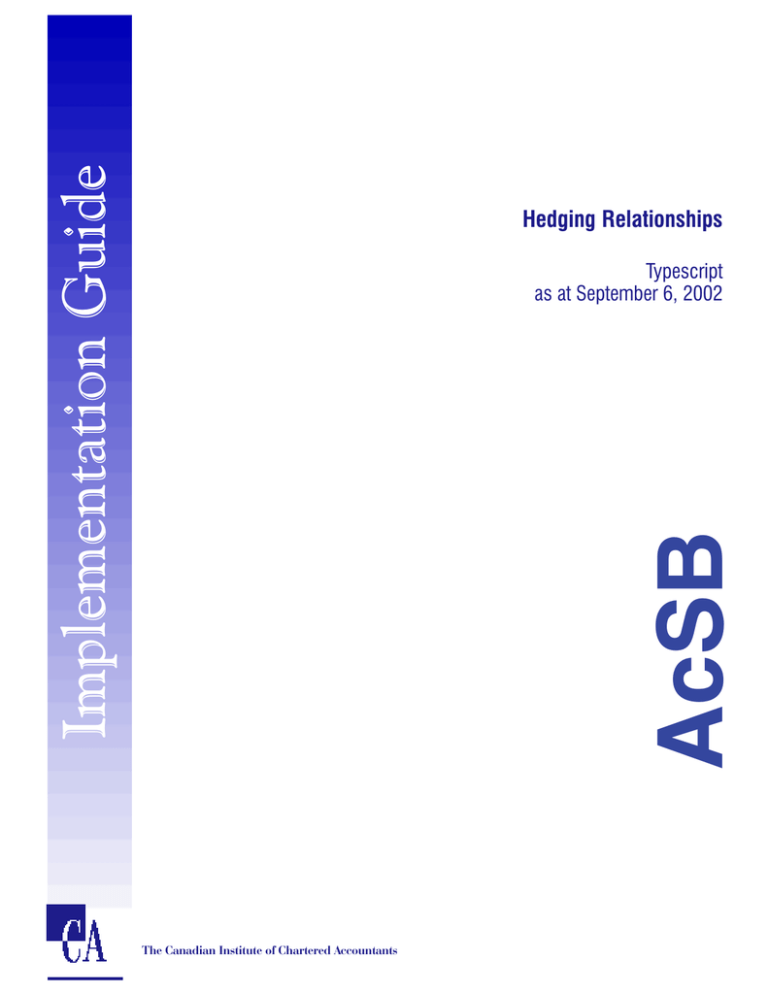
Implementation Guide Hedging Relationships AcSB Typescript as at September 6, 2002 The Canadian Institute of Chartered Accountants Typescript (subject to editorial change) – August 2002 FOREWORD The Accounting Standards Board (AcSB) approved Accounting Guideline AcG-13, Hedging Relationships, in October 2001. The new Guideline is effective for fiscal years beginning on or after July 1, 2002. The AcSB authorized the development of a series of questions and answers to assist in the implementation of the Accounting Guideline and to promote its consistent application. Readers are cautioned that the questions and answers must be read in conjunction with the Guideline, and are not a substitute for referring to it. The questions and answers published to date are part of a series, and more will follow as they become available. The assistance of the volunteer members of the Working Group who developed the questions and answers is gratefully acknowledged. The members and their affiliations are: Andre de Haan, CA (chair) Gordon Cetkovski, CA Rose Marie Clarke, CPA Luana Comin-Sartor, CA Jennifer Densmore, CA Gilles Henley, CA Karen Higgins, CA Gale Kelly, CA Paul Langill, CA Richard Nunn, CA Martine Pelletier, CA Ken Ryfa, CA Shuaib Shariff, CA Michael Strain, CA Hedging Relationships Ernst & Young LLP PricewaterhouseCoopers LLP BDO Dunwoody LLP Ernst & Young LLP Suncor Energy Inc. Raymond Chabot Grant Thornton LLP Deloitte & Touche LLP KPMG LLP Toronto-Dominion Bank Deloitte & Touche LLP Deloitte & Touche LLP Ontario Power Generation Canadian Imperial Bank of Commerce Ernst & Young LLP Implementation Guide • i Typescript (subject to editorial change) – August 2002 TABLE OF CONTENTS Open issues 1. Scope and definitions 1.01 1.02 1.03 1.04 2. Synthetic instrument accounting Derivatives with embedded written options Interpretation of paragraph 3 Basis swaps Hedging effectiveness 2.01 2.03 2.04 High correlation Premiums or discounts and time value of derivatives in the assessment of hedge effectiveness Periodic assessment 3. Fair value type hedges 4. Cash flow type hedges 5. Foreign currency hedges 6. Discontinuance of hedge accounting 7. Transition 7.01 7.02 7.03 8. Transitional provisions Documentation on transition Balance sheet presentation and income recognition for derivatives no longer qualifying for hedge accounting Other 8.02 Hedging stock-based compensation and stock-based payments Hedging Relationships Implementation Guide • ii Typescript (subject to editorial change) – August 2002 OPEN ISSUES The Working Group is currently discussing the following issues. The inclusion of an issue on this list is not an indication that guidance will necessarily be provided. 1. Scope and definitions 1.05 Hedging an entity’s own equity 1.06 Equity derivatives linked to a company’s own equity 1.07 Hedging business combinations 1.08 Accounting for a group of items as the hedging item 1.09 Grouping similar assets 1.10 Definition of a derivative 1.11 Commodities as the hedged item 1.12 Portion of a derivative not hedged 1.13 Disclosure of hedging and non-hedging gains 2. Hedging effectiveness 2.02 Changes in the method of assessing effectiveness 2.05 A portion of a hedged item and a hedging item 2.06 Partial term hedging 2.07 Hedging the benchmark interest rate 2.08 Critical terms method of assessing effectiveness 2.09 Portfolio hedges 2.10 Hedging managerial cash flows 2.11 Freestanding derivatives as hedged items 2.12 Assuming no ineffectiveness in a hedge with an interest rate swap 3. Fair value hedges no issues 4. Cash flow hedges 4.01 Cash flow hedges where there is a change in the related underlying contract 4.02 Revenue hedges 4.03 An anticipated transaction as a hedge of another anticipated transaction 5. Foreign currency hedges 5.01 Hedging foreign currency risk of a subsidiary 5.02 Hedging anticipated foreign currency transactions with a forward contract 5.03 Net investment hedges using cross currency interest rate swaps 5.04 Forward points – net investment hedges 6. Discontinuance of hedge accounting 6.01 Discontinuing hedge accounting Hedging Relationships Implementation Guide • iii Typescript (subject to editorial change) – August 2002 7. Transition no issues 8. Other 8.01 Internal hedging relationships 8.03 Scope differences with FAS 133 Hedging Relationships Implementation Guide • iv Typescript (subject to editorial change) – June 2002 1. SCOPE AND DEFINITIONS 1.01 Synthetic instrument accounting Question: In the following examples would synthetic instrument accounting as described in paragraph 15 of AcG-13 override the requirements of AcG-13 for applying hedge accounting? (a) A company that measures its transactions in the Canadian dollar (i.e., has the Canadian dollar as its currency of measurement) uses a derivative to hedge the risk of the fluctuation in US dollar currency exchange rates on its Canadian dollar debt by entering into a derivative that effectively converts its debt into US dollars. (b) A company measures its transactions in the Canadian dollar (i.e., has the Canadian dollar as its currency of measurement). It has a US subsidiary that it considers self-sustaining. The Canadian company issues Canadian dollar debt with a floating interest rate. It enters into a swap that economically converts the debt into US dollar debt with a fixed interest rate. In isolation, neither the Canadian dollar debt nor the cross-currency interest rate swap would be an effective hedge of the foreign currency risk related to the company’s net investment in its US subsidiary. The company designates its Canadian dollar debt and the derivative as a hedge of a net investment in a self-sustaining foreign operation that uses the US dollar as its currency of measurement. Answer: In general paragraph 15 of AcG-13 states that synthetic instrument accounting can only be applied if the conditions outlined in paragraph 6 of AcG-13 are met. Paragraph 6(c) states that “both at the inception of the hedging relationship and throughout its term, the entity should have reasonable assurance that the relationship will be effective…” Accordingly, synthetic instrument accounting may be used if the hedging instrument is part of a hedging relationship that meets all of the criteria for hedge accounting, including hedge effectiveness. (a) No. In this particular example, an entity with the Canadian dollar as its currency of measurement does not have any foreign exchange risk related to its issued Canadian dollar debt. Accordingly, a derivative used to convert the debt into a foreign currency will not be effective in offsetting any risk related directly to the hedged item and synthetic instrument accounting may not be applied. However, the derivative in question could be effective as a hedge of another risk and thus could be eligible as a hedging instrument. Hedging Relationships Implementation Guide Typescript (subject to editorial change) – June 2002 (b) Yes. AcG-13 does permit combinations of items that individually meet the definition of a hedging item to be the hedging item in a hedging relationship. For example, assuming that all other requirements of AcG-13 are met, the company could designate the Canadian dollar debt and the derivative as a hedge of a net investment in a self-sustaining foreign operation that uses the US dollar as its currency of measurement. In determining whether the hedging item is effective, the combination would be considered. Hedging Relationships Implementation Guide Typescript (subject to editorial change) – June 2002 1.02 Derivatives with embedded written options Question: A cancelable swap, for example, is a swap with an option giving one of the counterparties the right (but not the obligation) to terminate the swap without penalty (or payment of fair value) before its original contractual maturity date. Paragraphs 27 and 28 of AcG-13 significantly limit the circumstances in which entities may designate a written option to be a hedging item. Should a derivative with an embedded written option, such as a cancelable swap, be considered to be a written option itself? Answer: Yes. When a written option is embedded in a derivative, the counterparty can compel the option writer to enter into a transaction that is unfavourable to the option writer. For example, in the case of a cancelable swap, the counterparty can compel the option writer to release the counterparties from a swap that is favourable to the option writer. A derivative with an embedded written option should be considered to be a written option. A derivative with an embedded written option may be designated as a hedging item only if the requirements of paragraphs 27 and 28 are met. Hedging Relationships Implementation Guide Typescript (subject to editorial change) – June 2002 1.03 Interpretation of paragraph 3 Question: Is hedge accounting appropriate when gains, losses, revenues and expenses for a hedged item and the hedging item will be recognized in the same accounting period regardless of whether hedge accounting is applied? For example, may hedge accounting be applied for a forward exchange contract taken out at the beginning of a quarter to hedge a foreign currency sale that will occur in the quarter? If hedge accounting is permitted in the situation described above, is it necessary to meet all of the conditions in AcG-13, including the documentation and effectiveness requirements, before applying hedge accounting? Answer: AcG-13 defines hedge accounting as a method for recognizing the gains, losses, revenues and expenses associated with the items in a hedging relationship, such that those gains, losses, revenues and expenses are recognized in income in the same period when they would otherwise be recognized in different periods. Paragraph 3 states that hedge accounting is applied only when gains, losses, revenues and expenses on the hedging item are recognized in income in a different period than the gains, losses, revenues and expenses on the hedged item. The phrase “in a different period” in paragraph 3 should be interpreted as meaning “at a different time”; that is, hedge accounting is precluded only when gains, losses, revenues and expenses of the hedged item and the hedging item would affect earnings at the same time if hedge accounting were not applied. In the above example, if hedge accounting were not applied, the foreign currency sale would affect earnings of the quarter only at the time of sale. However, the forward exchange contract would affect earnings of the quarter each time exchange rates change. Accordingly, the sale and the forward contract affect earnings at different times within the quarter and it is appropriate to apply hedge accounting. By contrast, it would not be appropriate to apply hedge accounting to a foreign currency denominated receivable hedged by a foreign currency denominated payable, because exchange gains and losses on both the receivable and payable always would be recognized in earnings at the same time if hedge accounting were not followed; i.e., every time the foreign exchange rate changes. In order to apply hedge accounting, it is always necessary to meet all of the conditions in AcG-13, including the documentation and effectiveness requirements. Accordingly, the conditions of AcG-13 must be met to apply hedge accounting even when it is expected that gains, losses, revenues and expenses on hedged item and hedging item would be recognized in the same accounting period if hedge accounting were not applied. Hedging Relationships Implementation Guide Typescript (subject to editorial change) – June 2002 1.04 Basis swaps Question: Is hedge accounting possible in the following situations involving basis swaps? (a) Management enters into the swap to modify the basis of a specific asset or liability. For example, management acquires a basis swap to effectively convert a variable rate note from a prime to a three month BA rate basis. (b) Management enters into the swap to eliminate the cash flow risk of holding a variable rate asset and liability with different bases (e.g., to eliminate the mismatch from holding a prime rate based asset and a three month BA rate based liability). Answer: AcG-13 describes a hedging relationship as one established between a hedged item and a hedging item. A hedged item is all or a specified portion of an asset, liability or anticipated transaction, or group of similar assets, liabilities or anticipated transactions, having an identified risk exposure that an entity has taken steps to modify. A hedging item is all or a specified portion of an asset, liability or anticipated transaction, or a group of assets, liabilities or anticipated transactions, modifying a risk exposure identified in the hedged item, provided that nonderivative items in a group are all similar. For a hedging relationship to be effective, and thus qualify for hedge accounting, the entity must expect the relationship to be effective in achieving offsetting changes in the fair value or cash flows of the hedged item and the hedging item that are attributable to the hedged risk exposure and occur during the term of the relationship. (a) No. As explained above, a necessary condition for applying hedge accounting is that changes in the fair value or cash flows of the hedging item offset changes in the fair value or cash flows of the hedged item. Changes in the fair value or cash flows of a basis swap taken out to modify the basis of a specific asset or liability would not offset the changes in the fair value or cash flows of that asset or liability. Accordingly, the basis swap in this example, would not be eligible for hedge accounting. (b) Yes. Hedge accounting would be appropriate if (i) management designates the combination of the swap and the asset (or liability) as the hedging item and the liability (or asset) as the hedged item and (ii) the other criteria in AcG-13 for hedge accounting are met. See Issue 1.08 — Accounting for a group of items as the hedging item. Hedging Relationships Implementation Guide Typescript (subject to editorial change) – June 2002 2. HEDGING EFFECTIVENESS 2.01 High correlation Question: Paragraph 20 of AcG-13 states that “effectiveness requires a high correlation of changes in fair value or cash flows” (emphasis added). How should the term high correlation be interpreted? Answer: Hedge effectiveness is defined in paragraph 5(e) of AcG-13 as “the extent to which changes in the fair value or cash flows of a hedged item relating to a risk being hedged and arising during the term of a hedging item relationship are offset by changes in the fair value or cash flows of the corresponding hedging item relating to the same risk and arising during the same period.” The concept of high correlation is well established in US accounting literature and is often referred to in US practice in percentage terms. Practice in the US has accepted 80-125 percent as high correlation. This percentage represents the absolute change in the fair value (or cash flows) of the hedging item divided by the absolute change in the fair value (or cash flows) of the hedged item related to the hedged risk. Thus, if the fair value (or cash flows) of the hedging item increased by $80 and the fair value (or cash flows) of the hedged item related to the hedged risk decreased by $100, practice in the US considers this relationship to be highly correlated at 80 percent ($80/$100). Likewise, if the fair value (or cash flows) of the hedging item increased by $100 and the fair value (or cash flows) of the hedged item related to the hedged risk decreased by $80, US practice considers this relationship to be highly correlated at 125 percent ($100/$80). As a result, effectiveness may be interpreted as describing a hedging relationship where the changes in the fair value (or cash flows) of the hedging item are within 80-125 percent of the opposite change in the fair value (or cash flows) of the hedged item related to the hedged risk. This approach often is referred to as the “dollar offset” method. Alternatively, in the US, a statistically valid approach,* such as regression analysis, may be used to establish high correlation. When regression analysis is used to assess hedge effectiveness, current practice in the US is that at a minimum Rsquared should be 0.80 or higher and the slope of the regression line (as adjusted for the hedging ratio) should be between –0.80 and –1.25. No difference should arise between US and Canadian GAAP in determining whether a hedging relationship is effective. * The use of a statistically valid approach may permit entities to apply hedge accounting for the current period even though, from a dollar-offset analysis, the hedge appears ineffective. FASB DIG E7, Hedging — General: Methodologies to Assess Effectiveness of Fair Value and Cash Flow Hedges, provides guidance to assist in choosing or designing a method of assessing hedge effectiveness. Hedging Relationships Implementation Guide Typescript (subject to editorial change) – June 2002 2.03 Premiums or discounts and time value of derivatives in the assessment of hedge effectiveness Question: (a) Can the premium or discount in forward contracts or the time value component of an option be ignored for hedge effectiveness testing purposes? (b) If so, does AcG-13 specify how the premium or discount in forward contracts or the time value component of an option be recorded in income? Answer: (a) Yes. Paragraph 24(c) of AcG-13 states that “An entity’s documentation of its risk management objective and strategy will include its procedures for assessing effectiveness. Those procedures may state ... how the assessment will deal with the time value of derivative hedging instruments.” Accordingly, entities may exclude a hedging instrument’s time value or forward contract premium or discount from the assessment of hedge effectiveness. However, an entity should assess effectiveness for similar hedges in a similar manner; use of different methods for similar hedges should be justified. (b) No. AcG-13 does not specify how the premium or discount in forward contracts and the time value of a derivative should be recorded in income. However, in accordance with CICA 1650.53 entities generally defer and amortize the time value or the premium or discount of a derivative over the life of the derivative for hedges of on-balance sheet items other than hedges of net investments in self-sustaining foreign operations. In contrast, entities generally defer the time value or the premium or discount of a derivative used to hedge an anticipated transaction and recognize the time value when the underlying transaction affects earnings. If the anticipated transaction is no longer reasonably assured, the time value is recorded in income. Hedging Relationships Implementation Guide Typescript (subject to editorial change) – June 2002 2.04 Periodic assessment Question: How often should hedge effectiveness be assessed by an entity that does not prepare interim financial statements (e.g., non-public enterprises)? Answer: Paragraph 21 of AcG-13 provides that hedge effectiveness “is assessed, at a minimum, at the time an entity prepares its annual and interim financial statements.” Paragraph 21 contemplates the financial reporting process of Canadian public enterprises.* Further, paragraph 6(c)(ii) of AcG-13 requires regular periodic assessments of the hedging relationship over its term to determine that it has remained, and is expected to continue to be, effective. The requirement to perform periodic assessments imposes an obligation to assess hedge effectiveness on a more frequent basis than annually. Consequently, entities that do not prepare interim financial statements should nevertheless assess hedge effectiveness every three months, at a minimum. * Public enterprises are those enterprises that have issued debt or equity securities that are traded in a public market (a domestic or foreign stock exchange or an over-the-counter market, including local or regional markets), that are required to file financial statements with a securities commission, or that provide financial statements for the purpose of issuing any class of securities in a public market. Hedging Relationships Implementation Guide Typescript (subject to editorial change) – June 2002 7. TRANSITION 7.01 Transitional provisions Question: Paragraph 39 of AcG-13 states that hedge accounting has to be discontinued in the manner described in paragraph 37(c) for hedging relationships that do not meet the conditions for hedge accounting as at the date on which AcG13 is first applied. One common strategy which gave rise to hedge accounting prior to AcG-13 and which will not meet the conditions for hedge accounting under AcG-13 is the hedging of net exposures (often called a macro hedging strategy). Paragraph 37(c) states: “When an entity terminates its designation of a hedging relationship or a hedging relationship ceases to be effective, hedge accounting is not applied to gains, losses, revenues or expenses arising subsequently. However, the hedge accounting applied to the hedging relationship in prior periods is not reversed. Any gains, losses, revenues or expenses deferred previously as a result of applying hedge accounting continue to be carried forward for subsequent recognition in income in the same period as the corresponding gains, losses, revenues or expenses associated with the hedged item.” (italics added) In net exposure strategies, it is difficult to determine (or there is no way of determining) when the net exposure is settled and, accordingly, when the hedged item affects earnings. Given this situation, it could be difficult to determine when gains, losses, revenues or expenses previously deferred as a result of applying hedge accounting to net exposures prior to AcG-13 will have to be recognized in income in accordance with paragraph 37(c). How should previously deferred gains, losses, revenues or expenses relating to hedging of net exposures prior to AcG-13 be recognized in income in accordance with the transitional provisions of AcG-13? Answer: In cases where it is possible to determine when a net exposure (macro hedge) has been settled, deferred gains, losses, revenues or expenses previously deferred as a result of applying hedge accounting should be recognized in income in accordance with paragraph 37(c), that is, in the same period as the corresponding gains, losses, revenues or expenses associated with the hedged net exposure. However, for practical reasons, when it is not possible to determine when a net exposure has been settled, previously deferred gains, losses, revenues or expenses relating to hedges of a net exposure (macro hedging) should be recognized in income over the remaining term of the hedging item. Hedging Relationships Implementation Guide Typescript (subject to editorial change) – August 2002 7.02 Documentation on transition Question: AcG-13 must be applied to hedging relationships in effect in fiscal years beginning on or after July 1, 2002. Paragraph 39 states: At the beginning of the fiscal year in which this Guideline is first applied, an entity assesses its existing hedging relationships to determine whether they satisfy all of the requirements for hedge accounting. An entity may take steps at the beginning of the fiscal year in which this Guideline is first applied to satisfy any of the conditions in this Guideline that a hedging relationship did not previously satisfy, so that it may continue to apply hedge accounting to that relationship. For example, at the beginning of the fiscal year in which this Guideline is first applied, an entity may formally document its risk management objectives and strategy for undertaking hedging activities or document or designate an existing hedging relationship that had not previously been documented or designated in accordance with the Guideline. Hedge accounting is discontinued in the manner described in paragraph 37(c) for hedging relationships that do not meet the conditions in this Guideline as of the date on which it is first applied. Does paragraph 39 permit entities to continue to apply hedge accounting for existing hedging relationships that do not meet all of the requirements of AcG-13 on the date of initial application of AcG-13 provided that the entity has taken steps to satisfy those conditions after that date? If so, how long does an entity have to complete these steps? Answer: No, the last sentence of AcG-13 provides that hedge accounting must be discontinued for any hedging relationships that do not meet the conditions of AcG13 as of the first day of the fiscal year in which AcG-13 is adopted. Hedging Relationships Implementation Guide Typescript (subject to editorial change) – August 2002 7.03 Balance sheet presentation and income recognition for derivatives no longer qualifying for hedge accounting Question: (a) What is the correct accounting for a derivative instrument that was accounted for as a hedging item prior to initial application of AcG-13 but will not meet the requirements of AcG-13 to be a hedging item at the transition date?* (b) Would the result discussed in (a) also apply to a derivative instrument that was accounted for as a hedging item subsequent to the AcG-13 transition date but is de-designated as a hedging item by the entity or fails to satisfy the conditions for hedge accounting of AcG-13 at a future date? Answer: (a) When hedge accounting is discontinued as at the date on which AcG-13 is first applied, paragraph 39 of AcG-13 states that it has to be done in the manner described in paragraph 37(c) for hedging relationships that do not meet the conditions in AcG-13. Paragraph 37(c) states that when a hedging relationship ceases to be effective, hedge accounting is not applied to gains, losses, revenues or expenses arising subsequently. Therefore, the hedge accounting that was applied in prior periods is not reversed on transition and any gains, losses, revenues or expenses deferred previously continue to be carried forward for subsequent recognition in income in the same period as the corresponding gains, losses, revenues or expenses associated with the hedged item. Subsequent to the transition date, when the hedging item is a derivative instrument, it must be carried at fair value with changes in fair value arising after the transition date recognized in income in accordance with EIC 128, Accounting for Trading, Speculative or Non-Hedging Derivative Financial Instruments. EIC 128 requires that a derivative instrument that does not qualify for hedge accounting under AcG-13 be recognized in the balance sheet and measured at fair value. Accordingly, entities holding derivative instruments that will no longer be a hedging item upon initial application of AcG-13 should, on transition, recognize the previously unrecognized fair value of the derivative instrument as an asset or liability and recognize a corresponding deferred credit or deferred charge on the balance sheet. As described in paragraph 37 the deferred credit or deferred charge should be recognized in income on the same basis as the original hedged item. The entity should recognize subsequent changes in fair value of the derivative instrument as an adjustment to its carrying amount recognized on initial application of EIC-128 with the corresponding gain or loss recognized in current period income. * Transition issues related to macro hedges are discussed in Issue 7.01. Hedging Relationships Implementation Guide Typescript (subject to editorial change) – August 2002 (b) Yes. This balance sheet presentation and income recognition should also be applied to derivative instruments where the entity has decided to terminate the designation of a hedging relationship or the relationship fails to satisfy the conditions for hedge accounting at any date subsequent to the initial application of AcG-13. Appendix I Assumptions: Forward foreign currency contract hedging an anticipated February 15, 2003 transaction Required documentation and designation not completed on transition date so hedge accounting will not be applied subsequent to the transition date Transition date: January 1, 2003 Forward contract details Maturity date: Fair value at inception: Fair value on transition: Fair value on Jan 31, 2003: Fair value on maturity: Date January 1, 2003 January 31, 2003 February 15, 2003 Zero $50,000 gain $75,000 gain $70,000 gain Journal Entries Dr. Derivative asset $50,000 Cr. Deferred gain $50,000 Dr. Derivative asset $25,000 Cr. Profit & Loss $25,000 Mark derivative to market for change in fair value from Jan 1 to Jan 31 February 15, 2003 Dr. Profit & Loss $ 5,000 Cr. Derivative asset $ 5,000 Mark derivative to market for change in fair value from Feb 1 to Feb 15 (maturity date) February 15, 2003 Record settlement of derivative and recognition of previously deferred (pre-transition) derivative gain or loss Dr. Cash $70,000 Dr. Deferred gain $50,000 Cr. Derivative asset $70,000 Cr. Profit & Loss $50,000 Actuarial Valuation Method Hedging Relationships Implementation Guide Typescript (subject to editorial change) – August 2002 8.02 Hedging stock-based compensation and stock-based payments Question: May an entity hedge the exposure to variability in expected future cash flows attributable to changes in the entity’s share price that arises in unvested stock-based compensation that is accounted for pursuant to CICA 3870.38 (e.g., stock appreciation rights that call for settlement in cash or other assets)? Answer: Yes, but only if the hedging relationship meets the conditions prescribed by AcG-13. A hedging item indexed to an entity’s own stock may be designated as a hedge of the cash flow variability of expected future obligations associated with unvested stock-based compensation that is accounted for pursuant to CICA 3870.38 if the hedging item is classified as an asset in the entity’s financial statements. Paragraph 5(c) of AcG-13 states that a hedging item is all or a specified portion of an asset, a liability or an anticipated transaction* or a group thereof. Thus, an item that is classified as equity may not be designated as hedging item. See Q&A 1.06 for more guidance. CICA 3860 is the relevant guidance for determining whether an item indexed to an entity’s own stock involving various settlement methods is classified as an asset or liability or an equity instrument. CICA 3860.16 states: An obligation of an entity to issue or deliver its own equity instruments, such as a share option or warrant, is itself an equity instrument, not a financial liability, since the entity is not obliged to deliver cash or another financial asset. Similarly, the cost incurred by an entity to purchase a right to reacquire its own equity instruments from another party is a deduction from its equity, not a financial asset (emphasis added). Thus, only an item that does not give the entity the right to reacquire its own equity instruments may be designated as a hedging item. That is, a purchased call option on an entity’s own stock that only settles net for cash may be designated as a hedging item of the stock-based compensation described above; a purchased call option on an entity’s own stock that may be settled either for cash or for shares at the entity’s option may not be designated as a hedging item. The intrinsic value approach described in paragraph 23 and 24 of AcG-13 permits an entity to assess hedge effectiveness of a hedging relationship that involves a hedging item that provides only one-sided offset (e.g., a purchased option) or a collar, by comparing the intrinsic value inherent within the option or combination of options to the prices above or outside those specified in the hedging documentation (in other words, an entity is required to test effectiveness only * An anticipated transaction is any transaction expected to occur in the future that has not yet given rise to a recognized asset or liability (emphasis added). Hedging Relationships Implementation Guide Typescript (subject to editorial change) – August 2002 when the option is in-the-money). The following is an example of hedging relationship involving a SAR obligation (designated as the hedged item) with a purchased option (designated as the hedging item) utilizing the intrinsic value approach to assess the effectiveness: Assume on 01/01/X1, ABC Co. grants 10,000 stock appreciation rights (SARs) to Employee that vest at the end of Year X1 and are indexed to the quoted market price of ABC Co.’s stock. The SARs have a stated price of $10 per SAR, which is the current market price of ABC Co. stock. Employee may elect to receive cash or ABC Co. stock on 12/31/X1 equal to the market appreciation from the date of grant. Pursuant to CICA 3870.38, ABC Co. measures compensation cost as the amount by which the quoted market price of its stock exceeds $10 x 10,000 [(quoted market price - $10) x 10,000]. Changes, either increases or decreases, in the quoted market price of its stock between the date of grant and the measurement date result in a change in the measure of compensation for the SARs. Compensation cost is recognized on a straight-line basis over the vesting period. In order to hedge the cash flow variability of its expected obligation attributable to changes in the price of its common stock, ABC Co. contemporaneously purchases for $10,000 an atthe-money call option that matures on 12/31/X1. The purchased call option may be settled only for cash equal to the amount by which the quoted market price of 10,000 shares of ABC Co. stock exceeds $10. ABC Co. designates the purchased call option as the hedging item of the changes in cash flows of its SAR liability attributable to changes in the price of its common stock. Assume all AcG-13 hedge criteria have been met and that ABC Co. will assess hedge effectiveness by comparing cumulative gains on the purchased call option as measured by changes in its intrinsic value (i.e., the intrinsic value approach) with the cumulative changes in the expected future cash flows from the SAR liability. The premium paid for the call option is amortized over the life of the option on a straight-line basis. Assume the spot price (quoted market price) of ABC Co. shares as of the following dates is: $10.00 at 01/01/X1; $10.10 at 03/31/X1; $12.10 at 06/30/X1; $12.30 at 09/30/X1; and $14.80 at 12/31/X1. Assume fair value, and change therein, of the various components of the purchased call option from the inception of the hedging relationship are: A B A-B Call option Call option Call option Increase in fair value intrinsic value time value intrinsic value 01/01/X1 03/31/X1 06/30/X1 09/30/X1 12/31/X1 $10,000 9,000 26,000 24,000 48,000 $ − 1,000 21,000 23,000 48,000 $10,000 8,000 5,000 1,000 − $ − 1,000 20,000 2,000 25,000 Assume the cumulative expected cash flows on the hedged SAR liability, and the change therein, from the inception of the hedging relationship are: SAR Increase in liability SAR liability 01/01/X1 03/31/X1 06/30/X1 09/30/X1 12/31/X1 Hedging Relationships − (1,000) (21,000) (23,000) (48,000) $ $ − (1,000) (20,000) (2,000) (25,000) Implementation Guide Typescript (subject to editorial change) – August 2002 The following is the measurement of periodic compensation cost under CICA 3870 (assume Employee exercises SARs on 12/31/X1): 03/31/X1 06/30/X1 09/30/X1 12/31/X1 Stated price $ 10.00 $ 10.00 $ 10.00 $ 10.00 Spot price (quoted market price) 10.10 12.10 12.30 14.80 Compensation per SAR (c) 0.10 2.10 2.30 4.80 Number of SARs (d) 10,000 10,000 10,000 10,000 Total compensation (c) x (d) 1,000 21,000 23,000 48,000 Cumulative percent accrued 25% 50% 75% 100% Cumulative compensation 250 10,500 17,250 48,000 Compensation previously recognized − 250 10,500 17,250 Compensation cost for period $ 250 $10,250 $ 6,750 $30,750 Summary of deferred gains on the purchased call option*: 03/31/X1 06/30/X1 09/30/X1 12/31/X1 Opening balance (credit) Current period gain Reclass to earnings as gain $ − (1,000) 250 $ (750) (20,000) 10,250 $(10,500) (2,000) 6,750 $ (5,750) (25,000) 30,750 Closing balance $ (750) $(10,500) $ (5,750) $ 09/30/X1 12/31/X1 $23,000 $(17,250) $ 48,000 $(48,000) Amounts reported in the financial statements (debit (credit)): 03/31/X1 06/30/X1 Balance sheet: Purchase call option $1,000 $ 21,000 SAR liability† $ (250) $(10,500) − Option premium $7,500 $ 2,500 $ − Deferred gain $ (750) $(10,500) $ (5,750) $ − $ 250 $ 10,250 $ 6,750 $ 30,750 (250) 2,500 $2,500 (10,250) 2,500 $ 2,500 (6,750) 2,500 $ 2,500 (30,750) 2,500 $ 2,500 Income statement: Compensation cost Reclass from deferred gain on purchased call option Option premium Net income statement impact 5,000 * This example assumes ABC Co. recognizes 100 percent of the intrinsic value of the call option on the balance sheet and recognizes in earnings only the amount of the change in the intrinsic value equal and offsetting to the change in the SAR liability. The remaining intrinsic value of the call option is recorded as a deferred asset. Alternatively, ABC Co. could record on the balance sheet the amount of the intrinsic value that equals and offsets the aggregate change in the SAR liability (e.g., at 03/31/X1: Dr. Purchased Call Option $250; Cr. Earnings $250). † The SAR liability may not be offset against the call option on the balance sheet unless the conditions for offsetting in CICA 3860 have been met. Hedging Relationships Implementation Guide Typescript (subject to editorial change) – August 2002 The effect of ABC Co.’s hedging strategy is to limit the income statement impact of changes in the SAR liability. Although changes in the intrinsic value of the purchased call option completely offset the change in the SAR liability, ABC Co.’s income statement was affected by the amortization of cost of the purchased call option (i.e., the $10,000 premium). If, in our example, the SARs were to vest ratably over the period (e.g., 25 percent per fiscal quarter), paragraphs B63-65 would require ABC Co. to treat each fiscal quarter’s 25 percent of the SARs as a separate SAR plan. That is, in applying CICA 3870 and the conclusion reached in this issue, in order to hedge the SAR liability, ABC Co. would have to purchase four separate call options, each giving ABC Co. the right to cash equal to the amount by which the quoted market price of 2,500 shares of ABC Co. stock exceeds $10 x 2,500 and having exercise dates at the end of each quarter: a 3-month option; a 6-month option; a 9month option and a 12-month option. Hedging Relationships Implementation Guide


